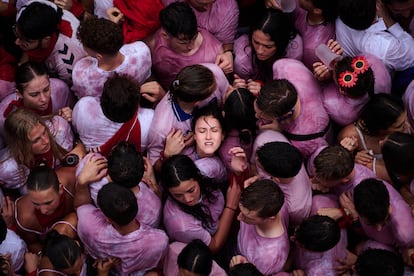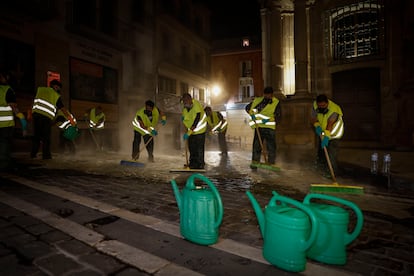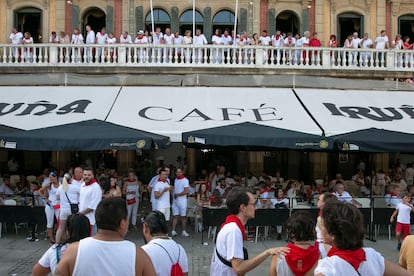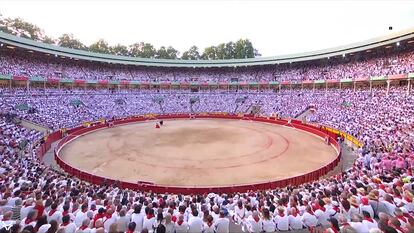Eight breakneck races, 2,500 runners a day and 16 ambulances: Pamplona’s Running of the Bulls is back
Occupancy rates are sky-high despite prices that can reach €1,000 a night, as thousands flock to the city to feel the thrill of San Fermín, ‘the mother of all Spanish fiestas’

The most impressive-looking bulls, the ones with the meanest-looking horns, are resting in the Corrales del Gas; the runners’ red-and-white outfits are looking pristine and perfectly pressed ahead of their use; the train and bus stations are a buzzing hive of visitors; hoteliers are rubbing their hands at the sky-high occupancy rates despite room prices that can reach €1,000 a night; bars and restaurants have stocked up on food and drinks ahead of a week of exhausting work. The historical city center is lined with wooden planks and posts; the gleaming bullring awaits the start of the festivities, and nerves are on edge.
This is the scene in Spain’s northern city of Pamplona ahead of the 2025 Sanfermines, a festival famously chronicled by Ernest Hemingway that draws thousands of visitors each year to what has sometimes been dubbed as the biggest party in the world and the mother of all Spanish fiestas. The capital of the history-rich region of Navarre will kick off events on Sunday with the traditional Chupinazo, a rocket fired from the balcony of City Hall to the delight of a chanting crowd packed in the square below and whose ebb and flow has been studied by scientists.
A conglomeration of 900 posts, 2,700 planks, 2,500 wedges and eight gates demarcate the 848.6-meter (half a mile) route that begins at Cuesta de Santo Domingo and ends at the bullring. There, every morning at 8 a.m. from July 7th to 14th, the bulls to be fought that afternoon will run from the pen to the ring among a crowd of young men and women who want to feel the thrill of risking their lives, or at least a good fall on the hard cobblestones. Between 200 and 300 people are typically injured each year, although in most cases the injuries are minor. There have been 15 fatalities since 1925.

Despite the appearance of anarchy, some basic rules must be followed to protect the physical safety of participants. The fence closes at 7:30, and by that time, law enforcement officers have already evacuated minors and anyone showing signs of having consumed alcohol or drugs. Objects that could obstruct the race, such as backpacks or cameras, are not allowed; touching or disturbing the bulls is prohibited, and in case of a fall, it is advisable not to get up and to protect your head.
Lack of symbols
The Sanfermines feature nine days of music, dancing and drinking in the streets, where hundreds of activities have been organized by the City Council, including exhibitions of Basque rural sports and parades of Gigantes y Cabezudos, papier-maché figures depicting giants and oversized heads. But the soul of the festivities lies in the figure of Saint Fermin, the patron saint of the city, and in the bulls themselves. Despite this, city officials have this year decided to showcase neither one in a promotional video that instead underscores the festival’s ability to bring people together, calling it “a time of encounters.”

Despite this, attention is geared toward the morning runs, which many people will witness from balconies along Cuesta de Santo Domingo, City Hall Square, Mercaderes and Estafeta streets; many more will get up early to watch the live coverage provided by Spain’s national broadcaster. Covering the distance takes around three minutes for six bulls chosen for that day’s bullfight, who are led by steers. Along with the animals, there are an average of 2,500 runners daily (which can balloon to 4,000 on weekends), of which only 6% are women.
Navarrese health authorities have established a team of nine stations at the foot of the fence, eight support points and more than 100 professionals, including doctors, nurses, technicians and other workers. There will also be 16 medical ambulances distributed throughout the route.
On Tuesday night, workers applied 1,500 liters of non-slip liquid in different areas of the run route, as they have been doing since 2005, to prevent the bulls from slipping, falling and fragmenting the herd. This treatment “increases the speed of the race and, ultimately, minimizes its danger,” according to the city.
Hotels starting at €500 a night
Hotels are welcoming guests at prices ranging from €500 to €1,000 per night, which has not prevented the Pamplona Hotel Association from estimating an average occupancy rate of 83.4%, higher than in 2024, rising to 90% on the days of peak demand, from July 6 to 9.

The city has published a leaflet containing basic recommendations “for a safe and civil festival.” It also emphasizes that Pamplona is a city with zero tolerance for sexist attacks and urges people to report them, in an unspoken reminder of a high-profile case involving a sexual assault in 2016 that made global headlines as the La Manada case and led to a national reckoning over the legal definition of sexual violence.

For the first time in the history of Pamplona’s bullring, a woman, the French rejoneadora Lea Vicens, is scheduled to participate in a bullfight on Sunday the 6th. Along with her, the other star will be the Peruvian bullfighter Roca Rey.
Sign up for our weekly newsletter to get more English-language news coverage from EL PAÍS USA Edition
Tu suscripción se está usando en otro dispositivo
¿Quieres añadir otro usuario a tu suscripción?
Si continúas leyendo en este dispositivo, no se podrá leer en el otro.
FlechaTu suscripción se está usando en otro dispositivo y solo puedes acceder a EL PAÍS desde un dispositivo a la vez.
Si quieres compartir tu cuenta, cambia tu suscripción a la modalidad Premium, así podrás añadir otro usuario. Cada uno accederá con su propia cuenta de email, lo que os permitirá personalizar vuestra experiencia en EL PAÍS.
¿Tienes una suscripción de empresa? Accede aquí para contratar más cuentas.
En el caso de no saber quién está usando tu cuenta, te recomendamos cambiar tu contraseña aquí.
Si decides continuar compartiendo tu cuenta, este mensaje se mostrará en tu dispositivo y en el de la otra persona que está usando tu cuenta de forma indefinida, afectando a tu experiencia de lectura. Puedes consultar aquí los términos y condiciones de la suscripción digital.
More information
Archived In
Últimas noticias
Most viewed
- Oona Chaplin: ‘I told James Cameron that I was living in a treehouse and starting a permaculture project with a friend’
- Sinaloa Cartel war is taking its toll on Los Chapitos
- Reinhard Genzel, Nobel laureate in physics: ‘One-minute videos will never give you the truth’
- Why the price of coffee has skyrocketed: from Brazilian plantations to specialty coffee houses
- Silver prices are going crazy: This is what’s fueling the rally










































